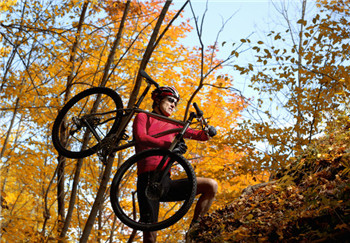(单词翻译:单击)

Almost any amount and type of physical activity may slow aging deep within our cells, a new study finds. And middle age may be a critical time to get the process rolling, at least by one common measure of cell aging.
一项新研究发现,不论运动量如何,几乎所有种类的体育活动都能延缓深藏于我们细胞内部的衰老过程。而中年可能是让这一机制继续运行下去的关键时段,至少,就衡量细胞衰老的一个常用指标而言确是如此。
Dating a cell’s age is tricky, because its biological and chronological ages rarely match. A cell could be relatively young in terms of how long it has existed but function slowly or erratically, as if elderly.
确定细胞的年龄可是个棘手差事,因为它们的生物学年龄(表明其组织结构和生理功能的状态)和实际年龄基本上对不上号。有些细胞论其存在时间可能还算年轻,但它们执行起生理机能来却十分缓慢或者不稳定,就如同衰老的细胞一样。
Today, many scientists have begun determining a cell’s biological age — meaning how well it functions and not how old it literally is — by measuring the length of its telomeres.
如今,许多科学家开始通过测量细胞的端粒长度来确定它的生物学年龄。
For those of us who don’t know every portion of our cells’ interiors, telomeres are tiny caps found on the end of DNA strands, like plastic aglets on shoelaces. They are believed to protect the DNA from damage during cell division and replication.
我们中的一些人对细胞内部的各个结构并不都那么了如指掌,那么,打个比方来解释一下,端粒是DNA链末端的小帽子,就像鞋带上的塑料箍一样。科学家们认为,它们可以防止DNA在细胞分裂和DNA复制过程中受到损伤。
As a cell ages, its telomeres naturally shorten and fray. But the process can be accelerated by obesity, smoking, insomnia, diabetes and other aspects of health and lifestyle.
随着细胞的衰老,其端粒自然也会磨损和缩短。但这一过程可能会因肥胖、吸烟、失眠、糖尿病等健康和生活方式问题而加快。
In those cases, the affected cells age prematurely.
在这种情况下,受影响的细胞就会过早衰老。
However, recent science suggests that exercise may slow the fraying of telomeres. Past studies have found, for instance, that master athletes typically have longer telomeres than sedentary people of the same age, as do older women who frequently walk or engage in other fairly moderate exercise.
然而,最近的科学研究表明,锻炼身体可以减缓端粒的磨损。例如,既往的研究发现,运动健将们的端粒通常比同龄的久坐者更长,在经常步行或从事其他适度运动的老年妇女中也有同样的现象。
But those studies were relatively narrow, focusing mostly on elderly people who ran or walked. It remained unclear whether people of different ages who engaged in a variety of exercises would likewise show effects on their telomeres.
但是,这些研究的面相对较窄,主要集中在经常跑步或步行的老年人身上。目前尚不清楚在不同年龄段的人群当中,从事多种运动是否也会对他们的端粒造成影响。
So for the new study, which was published this month in Medicine & Science in Sports & Exercise, researchers from the University of Mississippi and University of California, San Francisco, decided to look more broadly at the interactions of exercise and telomeres among a wide swath of Americans.
于是,在这项10月发表在《运动与锻炼中的医学与科学》杂志(Medicine & Science in Sports & Exercise)上的新研究中,来自密西西比大学(University of Mississippi)和加州大学旧金山分校(University of California, San Francisco)的研究人员们决定在广大的美国人群中更广泛地探讨一下运动与端粒之间的相互作用。
To do so, they turned to the immense trove of data generated by the ongoing National Health and Nutrition Examination Survey, for which tens of thousands of adults answer questions annually about their health, including their exercise habits, and complete an in-person health exam, providing a blood sample.
为此,他们把目光转向了正在进行的美国健康与营养调查(National Health and Nutrition Examination Survey)所产生的巨大的数据宝库。在这项调查中,成千上万的成年人每年都会回答有关他们自己的健康状况(包括运动习惯)的问题,接受体检,并提供血液样本。
In recent years, those blood samples have been tested for, among other markers of health, telomere length in the participants’ white blood cells.
近年来,研究人员对这些血样进行了化验,检测了参与者白细胞的端粒长度等多种健康标志物。
The researchers gathered the data for about 6,500 of the participants, ranging in age from 20 to 84, and then categorized them into four groups, based on how they had responded to questions about exercise.
研究人员收集了约6500名年龄在20岁到84岁的参与者的数据,然后根据他们对运动相关问题的回答,把他们分为四组。
Those questions in this survey tended to be broad, asking people only if, at any time during the past month, they had engaged in weight training, moderate exercise like walking, more vigorous exercise like running, or have walked or ridden a bike to work or school.
这项调查只是笼统地询问了受访者在过去的一个月里是否曾进行过任何负荷训练、或步行等中等强度的运动、或跑步等较为剧烈的运动,又或者曾步行或骑自行车上班或上学。
If a participant answered yes to any of those four questions, he or she earned a point from the researchers. So, someone who reported walking received a point. If he also ran, he earned another, and so on, for a maximum of four points.
在上述四个问题中,参与者的每一个肯定回答都会被研究人员计一分。因此,报告曾经步行过的人可以得一分。如果他还跑步了,就能再得一分,依此类推,最多可以得四分。
The researchers then compared those tallies to each person’s telomere length.
然后,研究人员比较了这些人的端粒长度及其得分。
And there were clear associations. For every point someone gained from any type of exercise, his or her risks of having unusually short telomeres declined significantly.
结果发现其间存在明显的相关性。无论受访者从事了何种类型的运动,他每得一分,端粒长度异常缩短的风险都会显著下降。
Specifically, someone who participated in a single activity, earning them a 1, was about 3 percent less likely to have very short telomeres than someone who didn’t exercise at all.
具体而言,如果某人因为参加某一运动而赢得1分,他的端粒特别短的可能性就会比不锻炼的人低3%左右。
That risk declined more substantially if someone exercised more. People who reported two types of exercise were 24 percent less likely to have short telomeres; three types of exercise were 29 percent less likely; and those who had participated in all four types of activities were 59 percent less likely to have very short telomeres.
一个人锻炼得越多,这种风险下降的幅度就越大。报告从事两种运动的人端粒特别短的可能性要降低24%;从事三种运动的人风险降低29%;参与了所有四种运动的人风险降低59%。
Interestingly, these associations were strongest among people between the ages of 40 and 65, the researchers found, suggesting that middle age may be a key time to begin or maintain an exercise program if you wish to keep telomeres from shrinking, says Paul Loprinzi, an assistant professor of health and exercise science at the University of Mississippi. He was a co-author of the study with Jeremy Loenneke, also of the University of Mississippi, and Elizabeth Blackburn, a professor at the University of California, San Francisco, who shared a Nobel Prize in 2009 for the discovery of the molecular nature of telomeres.
有趣的是,研究人员发现,这种相关性在40岁至65岁人群中最强。密西西比大学的健康与运动科学助理教授保罗·罗普林茨(Paul Loprinzi)认为,这表明,要是你不想让端粒缩短,中年可能是开始或者坚持锻炼计划的关键时段。他与密西西比大学的杰里米·伦内克(Jeremy Loenneke)、加州大学旧金山分校(University of California, San Francisco)的伊丽莎白·布莱克本(Elizabeth Blackburn)教授同为本研究的共同作者,而布莱克本教授曾因发现了端粒的分子性质而与其他人分享了2009年的诺贝尔奖。
However, as Dr. Loprinzi points out, this study is purely associational, so cannot show whether exercise actually causes changes in telomere length, only that people who exercise have longer telomeres.
然而,正如罗普林茨博士指出的那样,这项研究只是个纯粹的相关性研究,所以它只表示锻炼的人端粒较长,却无法说明运动是否确实会导致端粒长度的变化。
The study also couldn’t tease out the ideal amount of exercise for telomere maintenance, Dr. Loprinzi say, because the survey asked only whether someone exercised at all, not how frequently.
罗普林茨博士还说,由于调查只询问了受访者是否进行过锻炼,并没有问及锻炼的频率,所以这项研究无法确定要维持端粒长度所需的理想运动量。
Perhaps most important, the results don’t tell us whether longer telomeres translate into better health. But, Dr. Loprinzi says, other studies, including from his lab, “have shown that telomeres are predictive of mortality,” with shorter telomeres equating to shorter lives.
也许最重要的是,研究结果并没能告诉我们,端粒较长是否就代表着更加健康。但是,罗普林茨博士表示,包括他自己实验室的在内的其他研究“显示,端粒对死亡有预测意义”,较短的端粒就等同于较短的寿命。
So the message seems clear, he says. “Exercise is good” for your cells, and “more exercise in greater variety” is likely to be even better.
因此,个中启示很明确,他说,“运动对你的细胞有益”,且“越多地进行多种锻炼”效果可能就越好。


